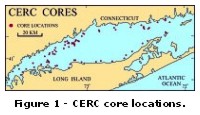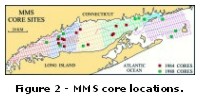|
      
 CERC cores
CERC cores
 1984 MMS cores
1984 MMS cores
 1988 MMS cores
1988 MMS cores
          
|
 Two major vibratory coring programs have been conducted in Long Island Sound, and their results are included
in this report. Both programs were conducted aboard the
ATLANTIC TWIN, a twin-hulled vessel of approximately 40-ton displacement, and used an Alpine Geophysical Associates, Inc. pneumatic, vibrating hammer-driven coring assembly. In this device, the vibrator sits atop a core pipe made of standard 4-inch steel pipe.
A metal H-beam, supported by four legs, serves as a support tower and a guide for the vibrator and core pipe. This coring device has the advantage of being able to recover long, continuous, relatively-undisturbed samples of the sea floor. The cores were collected in 3.5-inch diameter plastic-liner tubes. In the laboratory, the cores were split lengthwise into working and archive halves for sampling and photography. Two major vibratory coring programs have been conducted in Long Island Sound, and their results are included
in this report. Both programs were conducted aboard the
ATLANTIC TWIN, a twin-hulled vessel of approximately 40-ton displacement, and used an Alpine Geophysical Associates, Inc. pneumatic, vibrating hammer-driven coring assembly. In this device, the vibrator sits atop a core pipe made of standard 4-inch steel pipe.
A metal H-beam, supported by four legs, serves as a support tower and a guide for the vibrator and core pipe. This coring device has the advantage of being able to recover long, continuous, relatively-undisturbed samples of the sea floor. The cores were collected in 3.5-inch diameter plastic-liner tubes. In the laboratory, the cores were split lengthwise into working and archive halves for sampling and photography.
Various views of Alpine Geophysical Associates, Inc. coring assembly.
Clicking on an image will open a larger image in a new browser window.
 The first major coring program in the
Long Island Sound was conducted through the Inner Continental Shelf Sediment and Structure (ICONS) program of the U.S. Army Corps of Engineers Coastal Engineering and Research Center (CERC). This program, which collected 75 vibratory cores
(Figure 1), was directed toward mapping sand resources suitable for beach restoration, determination of regional engineering properties of shelf sediments, and effects of ocean dumping (Williams, 1981). These cores were subsequently redescribed in detail at Hampton University with funding from the USGS (Andrew Grosz, USGS, oral communication, 2001) to make them more useful for delineations of shelf structural characteristics and analyses of shelf history and sediment sources. Cores recovered from the Sound ranged from 1.3 to 5 m in length, and were collected in water depths that ranged from 3 to 30
m. The first major coring program in the
Long Island Sound was conducted through the Inner Continental Shelf Sediment and Structure (ICONS) program of the U.S. Army Corps of Engineers Coastal Engineering and Research Center (CERC). This program, which collected 75 vibratory cores
(Figure 1), was directed toward mapping sand resources suitable for beach restoration, determination of regional engineering properties of shelf sediments, and effects of ocean dumping (Williams, 1981). These cores were subsequently redescribed in detail at Hampton University with funding from the USGS (Andrew Grosz, USGS, oral communication, 2001) to make them more useful for delineations of shelf structural characteristics and analyses of shelf history and sediment sources. Cores recovered from the Sound ranged from 1.3 to 5 m in length, and were collected in water depths that ranged from 3 to 30
m.
 The
second major coring program was conducted between 1984-1988 as part of
a cooperative between the Minerals Management
Service (MMS) of the U.S. Department
of the Interior, the State of Connecticut, and the Association of
American State Geologists (AASG). The purpose of this program was to investigate
the geology of the inner continental shelf off southern New England. In
Long Island Sound, this effort was focused on verification of the systematic
high-resolution seismic-reflection surveys collected as part of a cooperative
between the State of Connecticut and the U.S. Geological Survey. As part
of this program, 13 vibratory cores were collected at 14 locations on
the seismic lines during 1984 (Figure
2). During 1988, 8 cores were collected in Long Island Sound and 3
cores were collected in Block Island Sound, all on the existent seismic
lines. Although not shown in
figure 2, 3 cores on this cruise were also collected further east
in Rhode Island Sound. Cores recovered ranged from 1.4 to 8.5 m in length. The
second major coring program was conducted between 1984-1988 as part of
a cooperative between the Minerals Management
Service (MMS) of the U.S. Department
of the Interior, the State of Connecticut, and the Association of
American State Geologists (AASG). The purpose of this program was to investigate
the geology of the inner continental shelf off southern New England. In
Long Island Sound, this effort was focused on verification of the systematic
high-resolution seismic-reflection surveys collected as part of a cooperative
between the State of Connecticut and the U.S. Geological Survey. As part
of this program, 13 vibratory cores were collected at 14 locations on
the seismic lines during 1984 (Figure
2). During 1988, 8 cores were collected in Long Island Sound and 3
cores were collected in Block Island Sound, all on the existent seismic
lines. Although not shown in
figure 2, 3 cores on this cruise were also collected further east
in Rhode Island Sound. Cores recovered ranged from 1.4 to 8.5 m in length.
|


